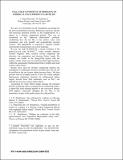Fully self-consistent 3D modeling of spherical Mach-probes in ExB fields
Author(s)
Patacchini, Leonardo; Hutchinson, Ian Horner
DownloadPatacchini-2009-Fully self-consistent 3D modeling of spherical Mach-probes in ExB fields.pdf (90.13Kb)
PUBLISHER_POLICY
Publisher Policy
Article is made available in accordance with the publisher's policy and may be subject to US copyright law. Please refer to the publisher's site for terms of use.
Terms of use
Metadata
Show full item recordAbstract
We carry out 3D particle-in-cell simulations accounting for the full ion distribution function, Boltzmann electrons, and the self-consistent potential profiles in the neighborhood of a sphere in a flowing magnetized plasma. This can be considered as the "spherical Mach-probe" problem, establishing how the ion flux to the surface varies with orientation, and with parallel and perpendicular external velocity. This dependence is required to interpret reliably experimental measurements on several tokamaks. We use our code SCEPTIC3D, a recent evolution of the particle-in-cell code SCEPTIC, which includes arbitrary uniform magnetic field, external velocity magnitude and direction, ion temperature and electron Debye length. We compare our results in the strong-field regime with the analytic model which uses an isothermal fluid approximation, within the quasineutral (infinitesimal Debye length) and small Larmor radius limits. Results show that for strongly magnetized plasmas the assumption of isothermal ions gives accurate flux, but can not be justified as the ion Larmor radius becomes finite. We then proceed with an in-depth analysis of how the widely adopted Mach-probe calibration formulas for infinitesimal Debye length are affected by nonzero Larmor radius effects. Accounting for finite Debye length changes the potential profiles around the sphere. In particular for conducting probes, a dipole-like field oriented parallel to the convective electric field appears, drastically changing the ion flow in the immediate vicinity of the probe, hence the collected flux.
Date issued
2009-08Department
Massachusetts Institute of Technology. Department of Nuclear Science and Engineering; Massachusetts Institute of Technology. Plasma Science and Fusion CenterJournal
IEEE International Conference on Plasma Science - Abstracts, 2009. ICOPS 2009
Publisher
Institute of Electrical and Electronics Engineers
Citation
Patacchini, L., and I.H. Hutchinson. “Fully self-consistent 3D modeling of spherical Mach-probes in ExB fields.” Plasma Science - Abstracts, 2009. ICOPS 2009. IEEE International Conference on. 2009. 1. ©2009 IEEE.
Version: Final published version
Other identifiers
INSPEC Accession Number: 10843973
ISBN
978-1-4244-2617-1
ISSN
0730-9244